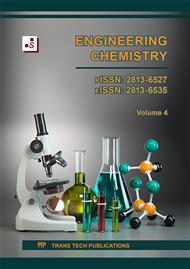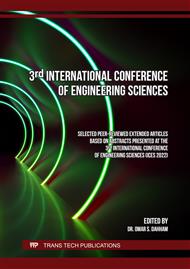[1]
Abdulraheim, A.M. (2018). Green polymeric surface active agents for crude oil demulsification. Journal of Molecular Liquids, 271, 329–341.
DOI: 10.1016/j.molliq.2018.08.153
Google Scholar
[2]
Wong, S.F., Lim, J. S., & Dol, S. S. (2015). Crude oil emulsion: A review on formation, classification and stability of water-in-oil emulsions. Journal of Petroleum Science and Engineering, 135, 498–504.
DOI: 10.1016/j.petrol.2015.10.006
Google Scholar
[3]
Al-Sabagh, A. M., Elsharaky, E. A., & El-Tabey, A. E. (2017). Demulsification performance and the relative solubility number (RSN) of modified poly(maleic anhydride-alt-1-dodecene) on naturally asphaltenic crude oil emulsion. Journal of Dispersion Science and Technology, 38(2), 288–295.
DOI: 10.1080/01932691.2016.1163720
Google Scholar
[4]
Vallejo-Cardona, A. A., Martínez-Palou, R., Chávez-Gómez, B., García-Caloca, G., Guerra-Camacho, J., Cerón-Camacho, R., Reyes-Ávila, J., Karamath, J. R., & Aburto, J. (2017). Demulsification of crude oil-in-water emulsions by means of fungal spores. PLoS ONE, 12(2), 1–17.
DOI: 10.1371/journal.pone.0170985
Google Scholar
[5]
Gong, H., Li, W., Zhang, X., Peng, Y., Yu, B., & Mou, Y. (2021). Effects of droplet dynamic characteristics on the separation performance of a demulsification and dewatering device coupling electric and centrifugal fields. Separation and Purification Technology, 257(October 2020), 117905.
DOI: 10.1016/j.seppur.2020.117905
Google Scholar
[6]
Gong, H., Yu, B., Dai, F., Peng, Y., & Shao, J. (2018). Simulation on performance of a demulsification and dewatering device with coupling double fields: Swirl centrifugal field and high-voltage electric field. Separation and Purification Technology, 207, 124–132.
DOI: 10.1016/j.seppur.2018.06.049
Google Scholar
[7]
Feitosa, F. X., Alves, R. S., & de Sant'Ana, H. B. (2019). Synthesis and application of additives based on cardanol as demulsifier for water-in-oil emulsions. Fuel, 245(September 2018), 21–28.
DOI: 10.1016/j.fuel.2019.02.081
Google Scholar
[8]
Li, Z., An, S., Liu, Y., Hua, Z., Li, F., Wang, X., Jing, B., & Tan, Y. (2019). Practical Modification of Tannic Acid Polyether Demulsifier and Its Highly Efficient Demulsification for Water-in-Aging Crude Oil Emulsions. ACS Omega, 4(24), 20697–20707.
DOI: 10.1021/acsomega.9b02933
Google Scholar
[9]
Abdulredha, M. M., Hussain, S. A., & Abdullah, L. C. (2020). Optimization of the demulsification of water in oil emulsion via non-ionic surfactant by the response surface methods. Journal of Petroleum Science and Engineering, 184(May 2019), 106463.
DOI: 10.1016/j.petrol.2019.106463
Google Scholar
[10]
Wu, J., Xu, Y., Dabros, T., & Hamza, H. (2003). Effect of Demulsifier Properties on Destabilization of Water-in-Oil Emulsion. Energy and Fuels, 17(6), 1554–1559.
DOI: 10.1021/ef030113e
Google Scholar
[11]
Ma, J., Li, X., Zhang, X., Sui, H., He, L., & Wang, S. (2020). A novel oxygen-containing demulsifier for efficient breaking of water-in-oil emulsions. Chemical Engineering Journal, 385, 123826.
DOI: 10.1016/j.cej.2019.123826
Google Scholar
[12]
Abdurahman H. Nour, F.S. Mohammed. (2009), Demulsification of Virgin Coconut Oil by Centrifugation Method: A Feasibility Study
Google Scholar
[13]
Lv, X., Song, Z., Yu, J., Su, Y., Zhao, X., Sun, J., Mao, Y., & Wang, W. (2020). Study on the demulsification of refinery oily sludge enhanced by microwave irradiation. Fuel, 279 (February).
DOI: 10.1016/j.fuel.2020.118417
Google Scholar



